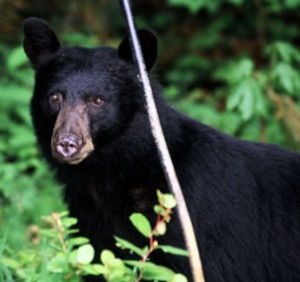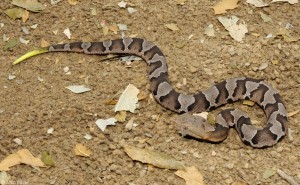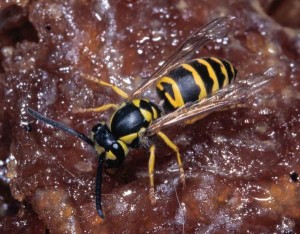Bears
 Black bears live along many parts of the Trail and are particularly common in Georgia, the Shenandoah and Great Smoky Mountains national parks, and parts of Pennsylvania and New Jersey. While attacks on humans are rare, a startled bear or a female with cubs may react aggressively. The best way to avoid an encounter while you are hiking is to make noise by whistling, talking, etc., to give the bear a chance to move away before you get close enough to make it feel threatened. If you encounter a bear and it does not move away, you should back off, speaking calmly and firmly, and avoid making eye contact. Do not run or “play dead” even if a bear makes a “bluff charge.”
Black bears live along many parts of the Trail and are particularly common in Georgia, the Shenandoah and Great Smoky Mountains national parks, and parts of Pennsylvania and New Jersey. While attacks on humans are rare, a startled bear or a female with cubs may react aggressively. The best way to avoid an encounter while you are hiking is to make noise by whistling, talking, etc., to give the bear a chance to move away before you get close enough to make it feel threatened. If you encounter a bear and it does not move away, you should back off, speaking calmly and firmly, and avoid making eye contact. Do not run or “play dead” even if a bear makes a “bluff charge.”
The best defense against bears in camp is preparing and storing food properly:
- Cook and eat your meals away from your tent or shelter, so food odors do not linger.
- Hang your food, cookware, toothpaste, personal hygiene items, and even water bottles (if you use drink mixes in them) in a sturdy bag from a strong tree branch at least ten feet off the ground and well away from your campsite. Make sure the bag is at least six feet from the trunk of the tree; black bears are crafty climbers and good reachers. Bear canisters also provide an effective alternative.
- Where bear boxes, poles, or cable systems are provided, use them. Never leave trash in bear boxes.
- Never feed the bears or leave food behind for them. That simply increases the risks to you and the hikers who follow behind you.
- A bear that enters a campsite or cooking area should be considered predatory. Yelling, making loud noises, throwing rocks, may frighten it away, however, you should be prepared to fight back if necessary.
If you are actually attacked by a bear, you should fight for all you are worth with anything at hand – rocks, sticks, fists.
Snakes
 Poisonous and nonpoisonous snakes are widespread along the Trail in warm weather, but they are generally passive. Please don’t kill them! Watch where you step and where you put your hands. Snakes are active at night in hot weather, so use a flashlight and wear shoes.
Poisonous and nonpoisonous snakes are widespread along the Trail in warm weather, but they are generally passive. Please don’t kill them! Watch where you step and where you put your hands. Snakes are active at night in hot weather, so use a flashlight and wear shoes.
Snake bites are rare, and bites from poisonous snakes do not always contain venom. Very few people die from snakebites in the U.S. If you are bitten by a snake you believe to be venomous, try to remain calm. Call 911 and seek medical treatment as quickly as possible. In the backcountry, this may mean walking out to a trailhead instead of waiting for emergency personnel to reach you. Wash the wound with soap and water. Do not apply ice. Do not apply a tourniquet; remove rings or other jewelry that could function as a tourniquet if swelling occurs. Do not use a “cut and suck” method to try and remove venom.
Yellow Jackets
 The small wasps called yellow-jackets make nests in abandoned animal holes in the ground. Standing next to or stepping on their nest is taken as a threat and they will attack in numbers. A yellow-jacket can sting repeatedly, sometimes trapped under a loose shirt or shorts. The stings are painful, but the danger is that your body may react to multiple stings by producing a swelling in your throat that shuts down your airway. This is life-threatening, so yellow-jackets are to be avoided. Be aware of small yellow and black wasps flying near the ground. They can be heard as well as seen. Watch where they go, and stay away from that hole!
The small wasps called yellow-jackets make nests in abandoned animal holes in the ground. Standing next to or stepping on their nest is taken as a threat and they will attack in numbers. A yellow-jacket can sting repeatedly, sometimes trapped under a loose shirt or shorts. The stings are painful, but the danger is that your body may react to multiple stings by producing a swelling in your throat that shuts down your airway. This is life-threatening, so yellow-jackets are to be avoided. Be aware of small yellow and black wasps flying near the ground. They can be heard as well as seen. Watch where they go, and stay away from that hole!
The yellow-jackets that land on your peanut butter and jelly sandwich will sting only if they are trapped. These are not defending the nest, so you are unlikely to be stung by more than one. Be careful to guard the opening of soft drink containers while drinking. A yellow-jacket that goes inside the container may sting you on the lips or tongue – more than once.
Note that yellow-jackets do not see you as a meal – they attack singly when trapped, or in a group when their nest is threatened.
